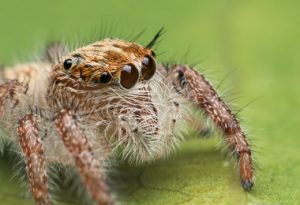
a newborn baby spider
Spiders go higher in the sky than any other living creature on our planet. Here is how it is done. When the baby spider is hatched, he just crawls up to a high point. It may be a grass stem or the side of a tree trunk, or a leaf on a plant. Then he upends – and off he goes!
Even though only a day old, he knows exactly what to do. Instead of a tail, the spider has a spinneret. Lifting it up in the air, he begins spinning his fine thread which catches in the wind and carries it away as the baby keeps reeling it out. Soon enough thread (about 9 feet [27.dm]) is in the air, and the baby is lifted off its feet and goes sailing!
This thread is actually a liquid which immediately hardens when the air touches it. For its size, the thread is stronger than steel, and can stretch without breaking.
Where did the baby learn this? Not from his mother. As soon as he becomes airborne, the little fellow climbs up on the silk line and walks on that fluttering thing as it is flying high! How can he do this and not fall off is a mystery. But he quickly become master of the airship.
Arriving about halfway along the line, he pulls on it, tugs it here and there, and reels it underneath him. In this way the line now becomes a rudder which he uses to steer up or down!
Where did a one-day old, with a brain one-thousandths as large as a pin-head, get such excellent flying instruction? Soon he lands on something but generally only long enough to prepare for another flight, and off he goes again.
Scientists in airplanes have found baby spiders 15,000 feet [4875 m] up in the air! That is 3 miles [4.8 km] high!
Eventually the tiny creature will land. It may be several miles down the road, in a neighbouring state, or on an island far out at sea. Spiders are the first creatures to inhabit new volcanic islands.

